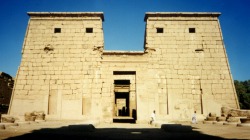
Name for the large entrance gateway to a temple, consisting of a gatehouse flanked by tall constructions in the shape of wide, tapering towers. Sometimes there are rooms and stairs within these towers whose function is still unclear. There are often tall, narrow grooves in the front of a pylon. These used to hold wooden flagpoles, as is shown in ancient representations of pylons. There were usually relief scenes on the front of the pylon as well, illustrating the power of the king. A scene showing him slaying his enemies was particularly popular. This activity was regarded by the Egyptians as an essential duty of the king, designed to preserve cosmic order (Maat). Because the entire temple was regarded as a symbol of the world, the outside walls near the entrance, the transitional area between the 'chaotic outside world' and the created world, were the most suitable place for a representation showing victory over the dark powers of chaos. The temple pylon was also connected with the creation and the temple as the cosmos in other ways. For example, because of its shape the pylon was associated with the two hills of the horizon between which the sun rose every day. It is also known that the temple was interpreted as an image of the primeval hill, on which the creator god appeared to begin his work. On a mythical level the two towers of the pylon were also identified with the goddesses Isis and Nephthys, whose job here was to assist the sun when it rose, just as they elsewhere assist Osiris with his resurrection. Larger temples often had several pylons. The temple of Amun at Karnak, for example, had no fewer than ten such constructions. The space between the walls of a pylon were usually filled with rubble, often including blocks from older, dismantled temples. An example of the latter are the so-called 'talatat' blocks from constructions of Amenhotep IV/Akhenaten.